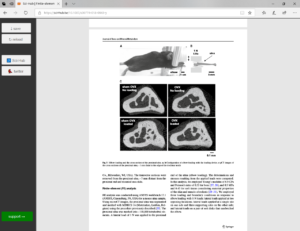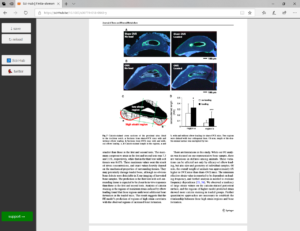Note: I’m still hard at work at finding a methodology of growing taller and am investigating non-LSJL method.
Finite-element analysis of the mouse proximal ulna in response to elbow loading.
“Bone is a mechano-sensitive tissue that alters its structure and properties in response to mechanical loading. We have previously shown that application of lateral dynamic loads to a synovial joint, such as the knee and elbow, suppresses degradation of cartilage{We also should investigate inducing endochondral ossification of the cartilage, perhaps Lateral Joint Loading could be involved in that} and prevents bone loss in arthritis and postmenopausal mouse models, respectively. While loading effects on pathophysiology have been reported, mechanical effects on the loaded joint are not fully understood. Because the direction of joint loading is non-axial, not commonly observed in daily activities{This is what’s so interesting about lateral joint loading, any height increase method has to be something that people do not do in ordinary activities as otherwise people would already have discovered that it makes you taller}, strain distributions in the laterally loaded joint are of great interest. Using elbow loading, we herein characterized mechanical responses in the loaded ulna focusing on the distribution of compressive strain. In response to 1-N peak-to-peak loads, which elevate bone mineral density and bone volume in the proximal ulna in vivo, we conducted finite-element analysis and evaluated strain magnitude in three loading conditions. The results revealed that strain of ~ 1000 μstrain (equivalent to 0.1% compression) or above was observed in the limited region near the loading site, indicating that the minimum effective strain for bone formation is smaller with elbow loading than axial loading{This is likely due to increases in fluid flow and/or hydrostatic pressure resulting in most of the adaptive response}. Calcein staining indicated that elbow loading increased bone formation in the regions predicted to undergo higher strain.”
“dynamic strain in bone matrix and strain-induced fluid flow in the lacuno-canalicular network are two of the major contributors to mechanotransduction in bone”
“Unlike axial loading, such as in ulna and tibia loading, joint loading employs lateral loads that sandwich a synovial joint, such as the knee, ankle, and elbow”<-I have not heard joint loading described this way before. This description emphasizes the lateral compression force.
” we determined the strain distribution to the ulna in response to elbow loading using a mouse model and finite-element (FE) analysis. Daily loading with 1-N peak-topeak force at 1 Hz for 5 min was applied to ovariectomized (OVX){OVX mice simulates osteoperiosis} mice as well as sham-OVX mice (control mice){we are more interested in this group}, and bone mineral density (BMD) was measured at the site of loading after 4 weeks of loading. ”
” We employed three loading configurations: load and a single point of support, load and a three-point support, and load across soft tissues that may mimic surrounding skin and muscle”
” The lateral loads to the elbow were given 5 min per day for 5 weeks using 1-N force (peak-to-peak) at 5 Hz to the right arm, and left arm data were used as a contralateral control. ”
 You can see the bone formation in the control group. Definitely doesn’t indicate that it increases height but it indicates that it does something which is a start. There seems to be an increase in bone width as well which is harder than just increasing the trabecular bone from within which is also very good although these mice are 12 week old female mice. But the increase in bone width indicates the possibility of abnormal effects going on which would be needed to induce height growth.
You can see the bone formation in the control group. Definitely doesn’t indicate that it increases height but it indicates that it does something which is a start. There seems to be an increase in bone width as well which is harder than just increasing the trabecular bone from within which is also very good although these mice are 12 week old female mice. But the increase in bone width indicates the possibility of abnormal effects going on which would be needed to induce height growth.
” We employed three loading and boundary conditions in response to elbow loading with 1-N loads: lateral loads applied at two opposing locations; lateral loads applied at a single site on one side and three supporting sites on the other side; and lateral loads on a pair of soft disks that sandwiched the elbow.”<-it’ll be interesting to see which is best. I think the soft disks would really diminish the load.
“Compression of a pair of soft-tissue disks induced multiple strain spots that were widely distributed from the proximal tip to the whole elbow joint ”
“Elbow loading generates artificial lateral forces that are rarely encountered during routine physical activity. Unlike axial or bending loads with ulna loading or tibia loading, the mechanical response of synovial joints, such as the elbow, to lateral loads has not been fully characterized” You can’t really see any abnormal bone formation here like you could in the earlier image and they look to be similar sites. “Calcein-stained cross sections of the proximal ulna distal to the trochlear notch” whereas the earlier one is “c μCT images of the cross sections of the proximal ulna, ~ 1 mm distal to the edge of the trochlear notch”
You can’t really see any abnormal bone formation here like you could in the earlier image and they look to be similar sites. “Calcein-stained cross sections of the proximal ulna distal to the trochlear notch” whereas the earlier one is “c μCT images of the cross sections of the proximal ulna, ~ 1 mm distal to the edge of the trochlear notch”
” Compared to strain at the single loading site, three supporting sites significantly reduced
the maximum compressive strain by ~tenfold (from ~ 2% in the dark blue label to ~ 0.1% in the cyan level). “<-So maybe one loading site is best. Multiple loading sites would counter the deformation and act as a sort of stabilizing force [cancel each other out]. “strains exceeding 0.1% (1000 μstrain) are confined to the vicinity of the loading site and supporting points”<-So maybe in someone that is growing we would we want to load directly near the growth plate or in an adult maybe near the articular cartilage.
Not very much height stuff but good to see it still being worked on.
